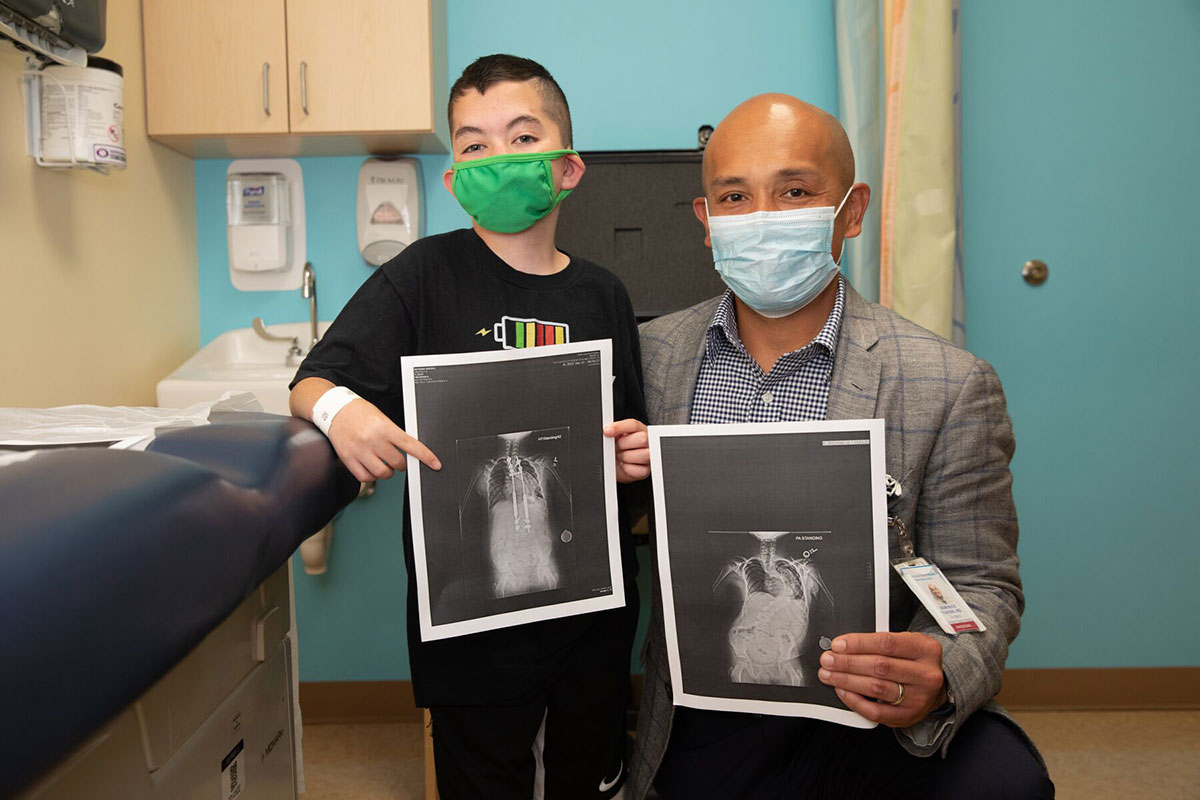
Popular Locations
- Outpatient Surgery - Bridgeport Hospital
- Park Avenue Medical Center
- Primary Care Center - Bridgeport Hospital

Published August 03, 2022

Liz Reynoso had taken her son, Justin, to see many doctors over the years to find out what could be done to stop the worsening curve in his spine.
At age 3, Justin was diagnosed with early-onset idiopathic scoliosis, a type of scoliosis with an unknown cause. “We had tried different interventions, but the curve kept getting worse,” his mother said. “He had worn braces and casts to slow it down but, unfortunately, he reached the point where surgery was inevitable.”
Justin was 10 years old when the family met with Dominick Tuason, MD, an orthopedic surgeon affiliated with Yale New Haven Children’s Hospital and Yale Medicine, who specializes in the treatment of pediatric spinal issues.
Dr. Tuason brings his expertise to several Pediatric Specialty Centers throughout the Yale New Haven Health System each week, including the Pediatric Specialty Center located at Park Avenue Medical Center in Trumbull. There, he consults with pediatric patients with spinal deformities, conducts follow-up exams and treats other orthopedic conditions.
Idiopathic scoliosis is the most common form of scoliosis. “It typically occurs when a child is going through a growth spurt,” Dr. Tuason explained. “For young ladies, it is usually somewhere between 10 and 12 years of age; for young men, it’s usually somewhere between 12 and 14 years of age.”
While some spinal curvatures respond to bracing, others require surgery.
“The gold standard or traditional surgical correction for scoliosis is a posterior spinal fusion,” Dr. Tuason said. A spinal fusion permanently connects two or more vertebrae in the spine, using screws and rods to hold the vertebrae together and stabilize the spine.
“When you have someone who is less than 10 years old, you typically don’t want to perform a surgical fusion because it stops the child from having any further growth in their trunk. You also want the child’s chest wall to be able to grow, so that their lungs can grow and they can breathe normally.”
For children with early-onset scoliosis, like Justin, surgical considerations are different.
“For rare cases, we do ‘growth-friendly surgery,’” Dr. Tuason said. “Technology has advanced, such that we can surgically place magnetic growing rods that can be lengthened over time, noninvasively."
In the past, these children had to come back every six months and undergo a surgical procedure to have the rods lengthened, he explained. Today, the lengthening process can occur in the office setting.
“In my practice, I lengthen magnetic rods every three months,” Dr. Tuason said. “It’s basically a one-minute procedure, where we place the remote controller on the child’s back and activate the device, so that the spine grows about 2 - 3 mm with each lengthening.”
As a first step, Justin underwent a procedure called halo-gravity traction. This method carefully stretches and straightens a curve in the spine, using weights and a pulley system to gently lift the patient’s head. Justin had a metal ring – or halo – attached to his head and remained in the hospital for three weeks during this process. Medicine can help relax muscles and control any discomfort children may experience at first, or as more weights are added.
These days, Justin’s follow-up visits are on an outpatient basis. He will continue to see Dr. Tuason every three months over the next three or four years for his magnetic-lengthening procedures. He will have his final surgery – a spinal fusion – when he is about 15 years old.
Today at age 11, Justin proudly stands almost 4-feet tall - 2¾ inches taller than he was before surgery.
“Prior to surgery, you could literally see the curvature of his spine,” his mother said. “He was very crooked and was very self-conscious about it. Today, he’s breathing better, he feels taller and straighter, and people have noticed. We are so incredibly grateful.”
Pediatric specialists from Yale New Haven Children’s Hospital are available for consultation and treatment at the Pediatric Specialty Centers throughout YNHHS. Learn more about services offered at the Pediatric Specialty Center at the Park Avenue Medical Center, 5520 Park Ave., Trumbull.